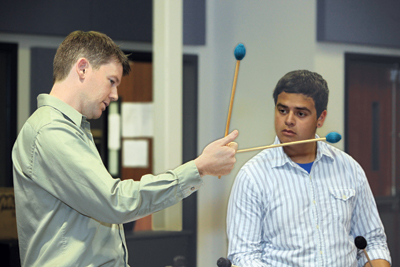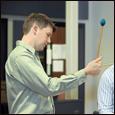
Young percussionists tend to have some common problems with mallet instruments, but band directors who are not percussionists may have a difficult time spotting some of them. Here are some easy fixes to these common problems.
Flammed Chords
Flamming can occur when two or more mallets playing a chord strike the bar at different times. This can happen when multiple players are playing the same chord, but it can also happen to just one person.
One possible cause of this is players’ mallets starting at different heights. Each mallet player should make sure his sticks are held at the same height, and all players should coordinate stick height for both the start and end of the stroke.
Another possibility is that a player is not bringing both mallets down at the same speed. If stick heights match, the director should watch carefully to see if mallet speed is the problem.
Playing on the Nodes
The nodes are the area on a keyboard percussion instrument where the cord runs through the key. Striking this area produces a less resonant and therefore undesirable tone. Young percussionists may be unaware of this problem and not pay attention to where the mallet strikes the bar. They may also not be listening to the sound and simply perceive any sound that comes from the bar as good, as long as there is a sound.
Show students the difference between playing on the node and playing on the middle of the bar. To get students to pay attention to mallet placement, have them practice something relatively simple, such as scales. They will probably find that they hit nodes fairly often.
Sometimes students hit nodes because they are standing too close to the instrument. Rather than strike in the middle of a bar, strokes will land on the nodes. Have close-standing students take a small step back from the instrument. This may feel awkward for some students, but they will quickly become accustomed to the distance.
It is worth noting that for accidentals, students can hit either the middle of the bar or the edge. In fast passages it is usually more desirable to strike the key on the edge because there is less distance to move.
Maintaining Tempo
Students may be unaware they are out of tempo if they have not been trained to listen to themselves and the ensemble. Some students also either don’t watch the conductor at all or use him as a timekeeper rather than keep time themselves. In addition, too few students practice with a metronome.
Students should practice with a metronome daily. Improvement will be gradual – usually over a period of months – but it requires daily work. It is ideal for students to purchase a metronome with a headphone jack so they can hear the click over their instruments.
I suggest you have players clap their parts to the metronome. Clapping will let them hear attacks more clearly and show whether a person is playing in time. Students who listen intently to their playing should be able to identify whether they are playing in time.
Roll Speed Too Fast
The bars on a marimba begin losing resonance if the roll strokes happen so fast that a bar is not allowed to vibrate. That a roll can be too fast is sometimes a revelation to students who are accustomed to playing rolls that match the tempo, which is the technique often taught on snare drum.
Students usually assume that the best sound is produced by fitting as many strokes as possible into the tempo. Explain that the type of sound obtained is more important than tempo. A roll should be at the speed that sounds best, and the best sound will be one that is sustained with as little pulsing from the stroke as possible. The sound should be similar to a person singing the syllable oh. By experimenting with roll speed, students will begin to hear the different amounts of sustain that different roll speeds create.
Not Enough Rebound
Inexperienced percussionists may not allow a stick or mallet to rebound off the bar when playing. This can lead to the use of a stroke with no rebound at slow tempos and one that has some rebound at fast tempos. This use of two different techniques can lead to production of different tones at various tempos as well as an inconsistent stroke.
I teach percussionists to think of the stroke as one motion, with the down and up parts connected. Young players frequently try to make these motions separate. In addition, students sometimes talk about how a mallet feels without looking at it to see what they are doing. It is important that students watch their stroke and describe what they see rather than what they feel. There is often a disconnect between the two. I also like to use analogies, such as bouncing a tennis ball, to describe a proper stroke.
Although good technique is important, be sure to remind mallet players that in addition to paying attention to stick heights and mallet placement, they should play musically as well. Style often suffers if there is too much focus on technique. With this perspective, mallet players will be well-equipped to use proper technique to play beautifully.






